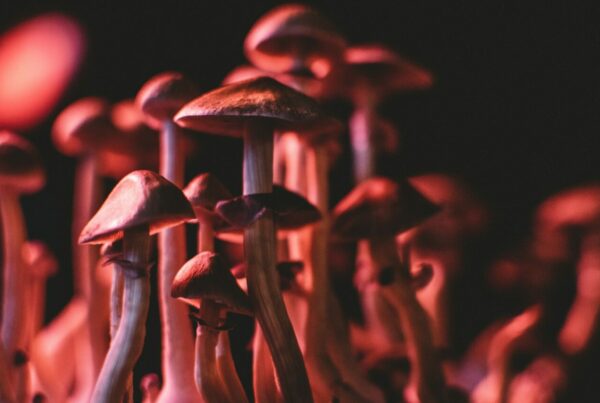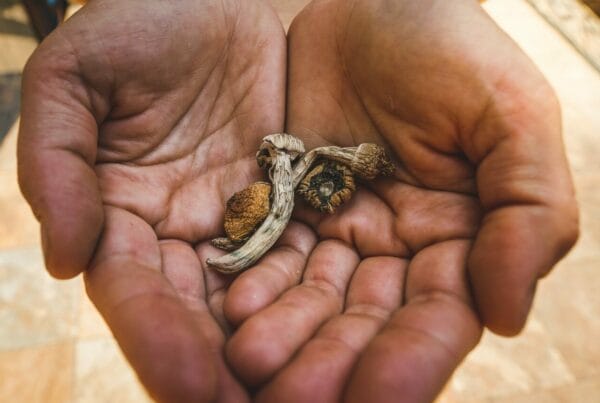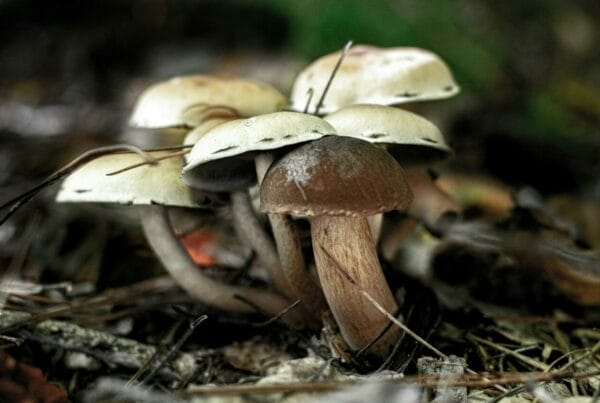Once viewed as simply a psychedelic curiosity, the strength of Psilocybe mexicana is now recognized and studied, thanks to ongoing psilocybin research. The psychedelic research community is steadily unveiling its therapeutic potential, progressively leading to its acceptance within the medical sphere. This emergent realm is seen as promising by experts who continuously work on identifying safe dosage for medicinal purposes.
Key Takeaways
- Researchers are utilizing advanced techniques like liquid chromatography coupled with tandem mass spectrometry to gauge the potency of such fungi.
- Psilocybe Mexicana, along with other mushroom species, is being scrutinized in clinical trials to evaluate its potential therapeutic applications.
- The genetic diversity in magic mushrooms is critical for creating an accurate dosage guide.
Psychedelic Mushrooms: From Mystery to Scientific Exploration
In the past, only a limited number of conditions were known to benefit from Psilocybe Cubensis. Today, however, psilocybin is making considerable progress in uncovering its latent medicinal qualities.
Experts are leveraging the potential of Psilocybe Mexicana and other potent strains for comprehensive research and clinical trials. Whether the experiments are conducted in vivo or in vitro, this strain proves effective in demonstrating the genuine effects and benefits of the fungi species.
Psychedelics in the Therapeutic Space
Once cloaked in mystery, psychedelic mushrooms are now unveiled, with ongoing discoveries increasingly capturing public attention—especially among those seeking therapeutic alternatives. Traditional mental health treatments often fall short, leading individuals to explore more effective solutions.
Enter the world of magic mushrooms.
People dealing with mental health disorders are turning to psilocybin, which has demonstrated potential in managing depression, alcohol addiction, anxiety, compulsive behaviors, tics, chronic pain, and more.
Currently, medical professionals are researching innovative methods to determine the optimal dosage for safe patient administration. Notably, a research team from the University of Texas has established a model to extract psilocybin and psilocin concentrations.
The medicinal potency of magic mushrooms can be clinically determined.
The Distinct Features of Mexicana
Golden Teachers, Blue Meanies, and B-Plus are among the magic mushroom species that have been thoroughly researched. However, for a comprehensive understanding of safe magic mushroom use, it’s necessary for researchers to study other species as well.
The Mexicana species has gained popularity in research circles, not only for its antiquity but also for its relatively lower potency, which is more likely to meet medical drug standards.
Despite the Mexicana strain’s less potent nature compared to other species, it can still provide effects similar to mainstream strains. With the rise of microdosing among patients, this strain offers an excellent alternative.
The Mexicana strain maintains consistent levels of psilocybin and psilocin, similar to other strains. So, what sets it apart? Its historical and anthropological significance is the key.
Delving Into the Rich History of “Mexicana”
The psilocybe mexicana naturally grew amidst moss in ancient times. Indigenous populations held these psilocybin mushrooms in high regard due to their diverse applications, often associated with mystical or supernatural occurrences.
Let’s focus on the Mexican mushrooms. They were first used by the natives of North and Central America over 2000 years ago. The Aztecs, a historical ethnic group, referred to these mushrooms as “the food of the Gods”, or “teonanácatl” in their language.
If the Aztecs were present today, they would validate the transformative, emotionally potent, and mentally balancing effects of the Mexicana, despite their unfamiliarity with these contemporary terms.
Even with different cultivation methods, this mushroom has successfully preserved its natural psilocybin levels, a testament to its authenticity. This authenticity is a standard that both researchers and institutions dedicated to psychedelic research highly appreciate.
Innovative Techniques for Testing Psilocybin Content and Potency
A team of ten researchers from the University of Texas at Arlington and other institutions have pioneered a new technique for testing the potency of psychoactive compounds in mushrooms. This innovative approach merges liquid chromatography and tandem mass spectrometry.
Below are two revolutionary techniques:
- Liquid chromatography is a technique that divides and scrutinizes chemical compounds. In this context, it’s utilized to analyze active chemicals found in mushrooms. The procedure includes running a liquid sample through a column packed with a stable material (the stationary phase). The various chemicals in the sample engage differently with the stationary and mobile phases, resulting in their separation at different rates as they progress through the column.
- Spectrometry typically focuses on the interaction of matter with electromagnetic radiation across a range of wavelengths. It determines and quantifies substances based on the unique wavelengths of light that molecules absorb and scatter. This assessment allows for the detection of the electronic, vibrational, and rotational states of the chemical.
This method was implemented on five magic mushroom strains. The investigators found that the mean total concentrations of psilocybin and psilocin across these strains varied from 0.879 to 1.36. These levels exceeded many strains, like Bull Run and Cambodian. The researchers confirmed the precision of their study by cross-referencing their findings with those from other independent laboratories.
The alignment of results between the two laboratories further endorsed the reliability of their testing process to accurately ascertain the potency of the mushrooms.
If these results are confirmed by specialists, they could add a new spectrum of techniques to the existing psychedelic strength test methods, serving as an added safety guard against unsafe dosage decisions.
Extending Research to Additional Species
Furthering research to include other species can be advantageous. It may improve our comprehension of the health benefits linked with different strains, and generate base data on the impacts of less potent mushrooms.
Moreover, it can contribute to educating individuals about the effects of different dosages on the psychedelic experience. Comparing Mexicans with stronger strains like Psilocybe Cubensis, researchers can ascertain how varying levels of active compounds can sway therapeutic results.
For example, the Blue Meanies strain yields more potent hallucinogenic effects, which could potentially be beneficial in managing conditions like depression. On the other hand, the latter is more suitable for microdosing or subtler uses such as mood enhancement or focus improvement.
Genetic Diversity Leads to Safer Treatments
It is often overlooked that different cultivars or varieties harbor distinct genetic profiles and
Different types of hallucinogenic mushrooms exhibit variations in their strength, components, and effects. Recognizing these differences enables healthcare experts to select the most suitable type for specific medicinal purposes and adjust doses to meet individual requirements, thus reducing potential risks and enhancing benefits.
Take, for instance, Psilocybe Semilanceata (Liberty Caps) or Psilocybe cyanescens. These mushrooms possess distinctive alkaloid profiles, which could be effective for anxiety treatment. On the other hand, other synthetically grown mushrooms might be more appropriate for tackling substance addiction or compulsive behaviors. This diversity aids in developing personalized treatment plans that are safer and more effective.
From this, we can infer that the genetic diversity among hallucinogenic mushrooms, complemented by innovative techniques for strength assessment and identification, plays a vital role in formulating safer medicinal treatments.
Enhanced Safety in Medicinal Use
Let’s pause for a moment to understand the potential benefits of safer dosage administration.
- Decreased risk of overdosing: Precision in dosing eliminates the risk of overdosing. This also underscores the need for clear product labeling to avoid consumer misinterpretation.
- Increased predictability: Accurate dosing allows individuals to anticipate possible effects or experiences during their trips. This can help reduce intense sensations and anxiety, thus improving patient satisfaction.
- Uniform measurement: Precise dosing can lead to a standardized metric, making it easier to refer to charts for potential effects.
Experience the Benefits of Accurately-dosed Mushrooms with Advanced Potency Tests | Shop Magic Mushrooms Online at Buy Shrooms Canada
With the continuation of these two groundbreaking techniques, unexpected effects will be a thing of the past. Pair this with smart online shopping at Buy Shrooms Canada. We offer dried mushrooms that promise a tranquil, relaxing psychedelic journey without excessive psychoactivity. Buy psychedelics online in Canada through Buy Shrooms Canada.
Frequently Asked Questions
Are Big Mexicans and Psilocybe Cubensis identical?
No, Big Mexicans and Psilocybe Cubensis are distinct strains of mushrooms, hence it’s crucial not to confuse the two. Big Mexicans have a higher compound isolation, ranging from 0.5% to 1%, making them significantly more potent. than Psilocybe Cubensis. It’s important to note the visual differences too: the former often showcases a bell-shaped cap, whereas the latter is more conical in appearance.
What is the highest concentration of Mexican mushrooms?
The concentrations of both psilocybin and psilocin in Mexican mushrooms can peak at 0.25%. Although these levels are relatively low, comparable to the Golden Teacher strain, they can still induce profound psychedelic experiences, which may carry potential health benefits.
What is the recommended dosage for medical safety?
The standard recommended dose typically falls between 1 to 2 grams. However, this can fluctuate based on elements like the method of consumption, individual metabolic rates, and the specific potency of the mushroom strain. Some individuals opt for sub-threshold doses that range from 0.05 (50mg) to 0.025 grams (250mg) in an attempt to reduce the hallucinogenic effects.





